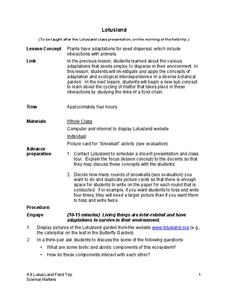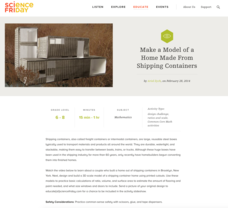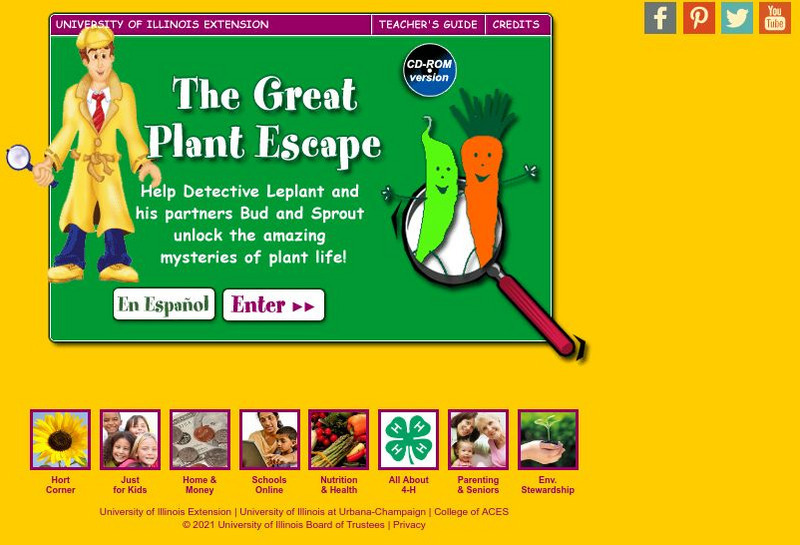Curated OER
Introduction to Watsonville Wetlands
Identify the different plants and animals found in wetlands, your class will explain the importance of wetland ecosystem and locate the different wetlands in their area.
Science Matters
Blubber Gloves: It’s All About Insulation
Instill the concept of adaptation with the help of Blubber Gloves—ziplock bags, shortening, and duct tape. Scholars discuss how animals and plants keep warm in polar regions, record their predictions, and try on their Blubber Gloves to...
University of Wisconsin
Bimodel Botany Bouquet
Gardeners are given an individual plant specimen from a bouquet of local rain garden plants. They group up by their plant type and then make observations together, name the plant, and introduce it to the rest of the class. You then share...
Science Matters
Lotusland
It's time for a field trip! Scholars take their new-found knowledge of adaptations and seed dispersal on a field trip to a local botanical garden. They gain an up-close look at how ecological interdependence works in a distinct...
Wild BC
Carbon - The Short and the Long
For this complex game about the carbon cycle, the playing field is divided into air, living, and earth zones. Children are assigned to be either plants or animals, and collect carbon tokens as they proceed from zone to zone. While the...
ARKive
Temperate Rainforest in the Pacific Northwest
Explore the amazing temperate rainforest of the Pacific Northwest. Your class starts by investigating the animals and plants of the Northwest, specifically Washington, and then research an animal population common to the area. In small...
American Museum of Natural History
Finding Fossils
How does one go about finding fossils? Find out with an informative webpage that looks at the digging process, showcases rocks and common fossils, helpful tips, and a list of archeological do's and don'ts.
Science Friday
Make a Model of a Home Made From Shipping Containers
Build a scale model of a home built out of shipping containers. A hands-on activity has scholars watch a video about a home built from shipping containers and then design their own home. They build scale models of their designed homes...
Alabama Learning Exchange
Alex: What Do Plants Need?
In this lesson, students will understand that in order to grow healthy plants, soil, water, light, and air must be provided. Students will use math skills such as measurement and science process skills such as observation, comparing, and...
Huntington Library
Huntington Library: Garden Lesson Plans: Rooting Into the Soil [Pdf]
An experiment to investigate the capacity of different soils to retain water, and how this impacts on the survival, evolution, and adaptations of plants. Extension activities are included.
Huntington Library
Huntington Library: Garden Lesson Plans: Learning From Leaves [Pdf]
An investigation into how light levels affect leaf adaptations in plants.
University of Illinois
University of Illinois Extension: The Great Plant Escape
Inspector LePlant and his friends look at the world of plants in this site for younger students. Features include the parts of plants and the seven basic requirements that plants need to survive as well as a short quiz.
Museum of Science
Museum of Science and Industry: Online Science: Activities: Habitat Overcrowding
An experiment where several containers are set up with different numbers of seeds planted in each. The objective is to investigate how seed density affects the health of the plants that grow.
PBS
Pbs Learning Media: Nature Cat: Story Exploration Packet (Spanish)
Mientras ven Nature Cat, utilice estas herramientas para guiar las discusiones y actividades de aprendizaje. Tally ho!
PBS
Pbs Learning Media: Nature Cat: Story Exploration Packet
As you watch Nature Cat, use these tools to guide discussions and learning activities. Includes printables on story elements, alternate endings, vocabulary words, character traits, an episode map, and a Venn diagram.









![Huntington Library: Garden Lesson Plans: Rooting Into the Soil [Pdf] Activity Huntington Library: Garden Lesson Plans: Rooting Into the Soil [Pdf] Activity](https://d15y2dacu3jp90.cloudfront.net/images/attachment_defaults/resource/large/FPO-knovation.png)
